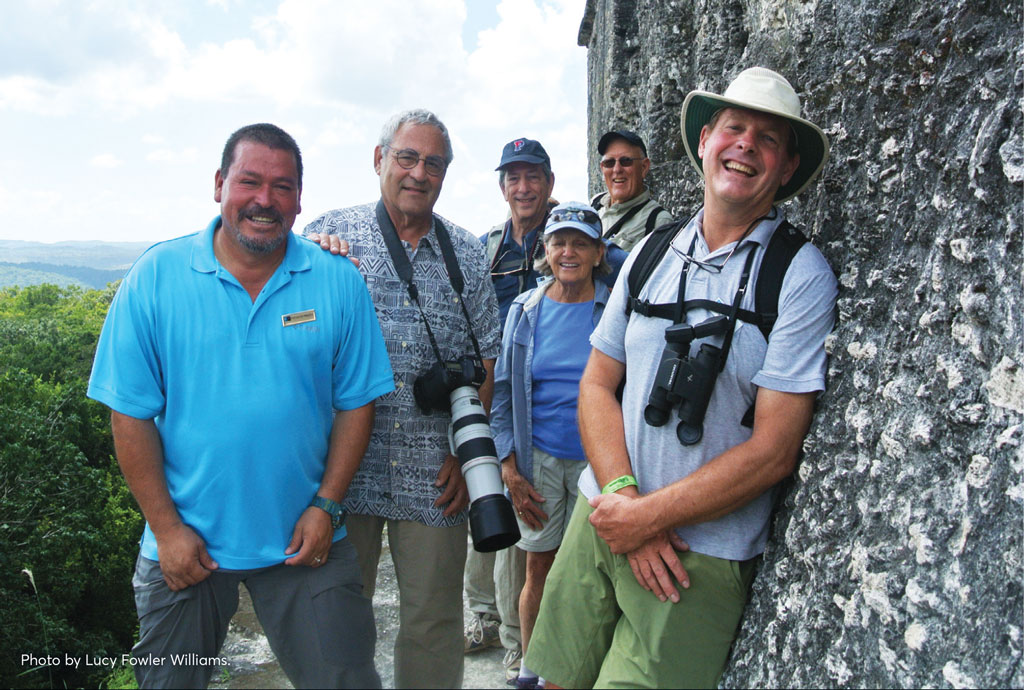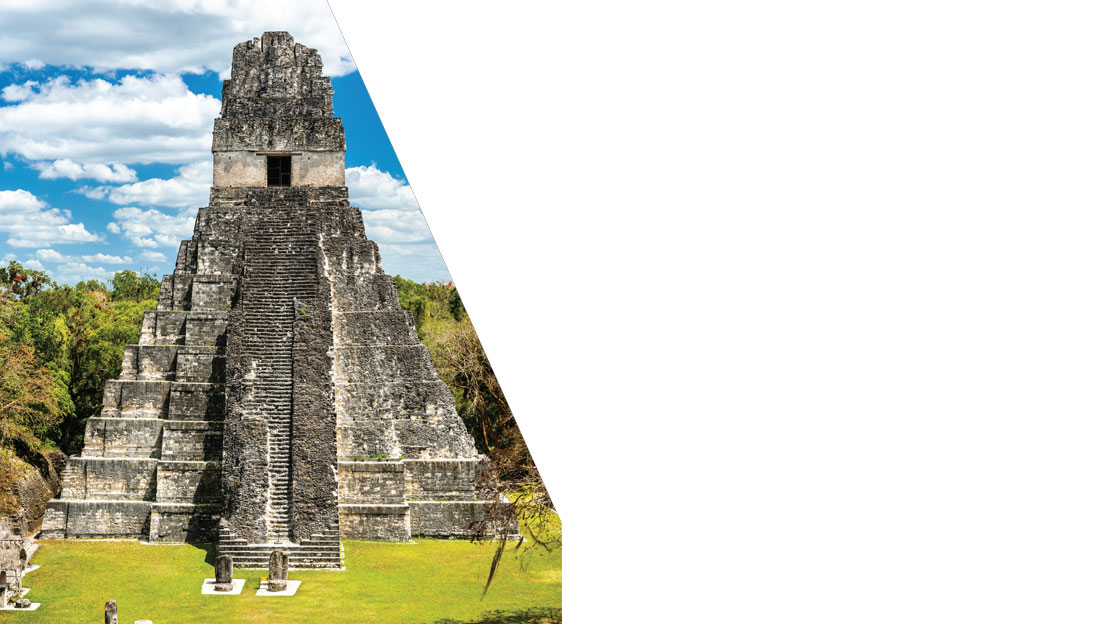
Tikal—Oasis in Time and War
[authors]
Fernando Madrid was born 20 miles from Tikal in El Remat Village at the start of Guatemala’s Civil War. In 1973, when he was just nine years old, his father was killed by the Guatemalan Army. The Director of the Tikal National Park quickly and quietly moved 16 Maya families inside the Park boundary to be safe from the killing. With his eight brothers and sisters, Fernando lived his entire childhood inside the Park. They created a small primary school and lived among the protected ruins through the armed conflict of his generation. Today, as a professional tour guide, he introduces visitors to Maya ideas and the back alleys and secrets of the Park. Of mixed heritage, he speaks Spanish, English, Italian, and Kekchi, the Maya language of his family. With deep admiration for the Penn Museum’s archaeological investigations at Tikal, he shared his passion over Zoom in 2020. What follows is adapted from our conversation.
In 1989, the tourism industry in Guatemala started up again. At Tikal, a small group of us boys and girls started to do this job extemporaneously. The life inside there was completely different with respect to the other villages around Tikal; it was an oasis. We were living through the internal conflict, all the problems of the social crisis of Guatemala, but Tikal was different, it was like a paradise. We were 16 families living inside the Park. All the boys and girls were friends and we played together. We studied at the Tikal school and in the afternoons and on weekends we sold soft drinks behind the main plaza to raise money to support our families—Coca Cola, Fanta, Pepsi, and, of course, beer. We took the drinks from the small shops and restaurants and profited 15 or 20 cents for each one.

When I was 15, I started to work in the Jungle Lodge Hotel—the camp for the University of Pennsylvania archaeologists. Mr. Ortiz, the owner, gave us the opportunity to start working there as housekeepers and to learn about tourism. He gave me the opportunity to study at the trade school Instituto Técnico de Capacitacion (INTECAP) when I was 15. At 17, I started work as a tour guide at the hotel, a year before I got my diploma.
I have known a lot of the archaeologists because they always came to meet Mr. Ortiz at the Jungle Lodge. I remember Christopher Jones and Michal D. Coe who wrote important books on the Maya. Chris Jones was very, very good because he clearly explained the relation- ships between the Maya cities. He never spun fantastic stories, but instead stayed very close to the archaeological evidence. If you read Chris Jones, you can see more of the real story of the relationship of the cities such as Dos Pilas (to the southwest) and Calakmul (to the north). I continue to take information from his work for this reason. He was a very kind and generous man and open to the people. He always talked with us to answer our questions and explain the different theories.
My colleagues and I believe Penn archaeologists did a great job because they were preservationists. They tried to leave the architecture in its original aspect. They never rebuilt it, they just restored it. That is the way to respect the ancient Mayas, and the visitors as well. Visitors often say of Mexico at Chichén-Itzá, for example, that they rebuilt that, but here at Tikal we can see the original monuments.
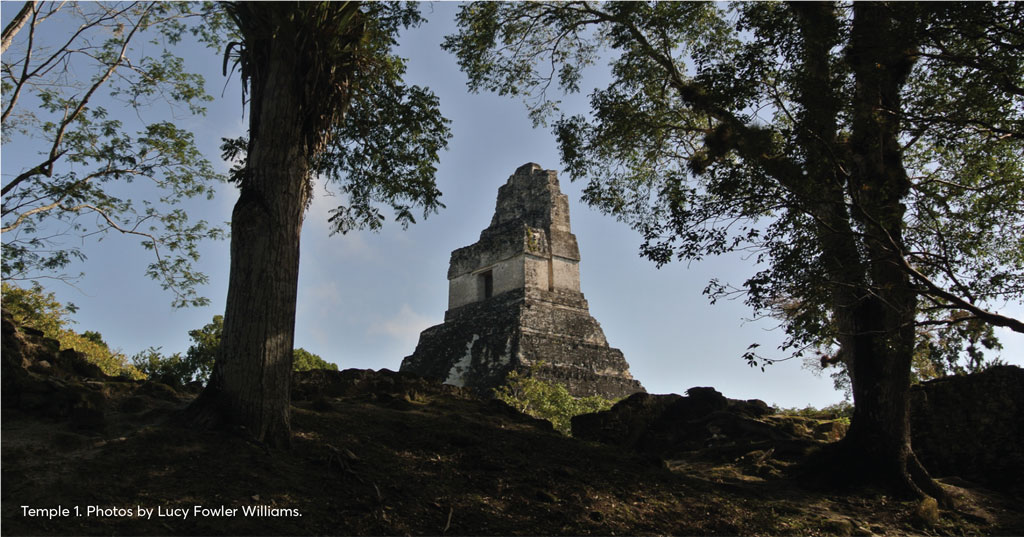
For me, the most impressive monument at Tikal, where I feel most connected, is Temple 1. I feel it is talking to me, like a man standing up and telling me his personal history. The second most impressive thing is the nature around Tikal. It is like a little basket full of treasures on a green carpet.
Most people who come here are unfamiliar with Maya culture. You need to create context in a dynamic way to explain. My favorite topic that brings all the structures together is Maya philosophy. It helps explain what they were thinking. This is the key to understanding the Maya sites, especially at Tikal, the largest of them all. How they canonized their knowledge for the common people really interests me. If you do this, it is easier for visitors to understand the place. Linda Schele’s work was amazing. Linda took the risk to start talking about Maya beliefs and philosophy at a higher level. The other archaeologists are more conservative. She took the great risk to try to understand and to try to explain the deepest ideas and elements of Maya culture. Her book, of course, that is so important is The Maya Cosmos: Three Thousand Years on the Shaman’s Path (1995).
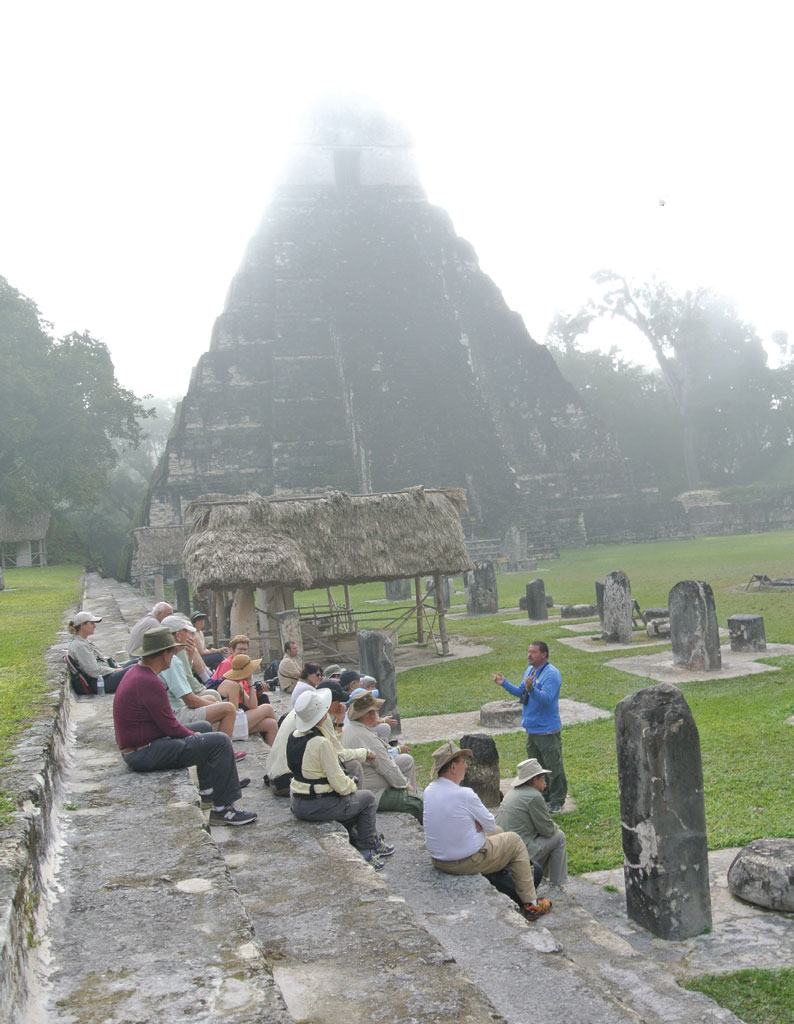
For me, the key to Maya religion was time. The calendar structures the religion and is used to control the masses. I like explaining the cyclical movement of time. If you know the past you can explain the future. Knowing time is cyclical, you can create the perfect religion with prophecies and lots of predictions because you know things will happen at a precise moment. The common people didn’t know this, and they thought oh, he speaks with god. The calendar was the key to the Maya government. They used nature to explain life.
Deep Knowledge of Nature Through Close Observation
I talk with visitors about the cosmovision as the first step because this offers the magical explanation of nature. When you observe, you realize nature has rules. When you understand nature is cyclical, and if you calculate the cycles of time, you can know how nature works and you can pass to the other level, the cosmology. When you have cosmology, you just need one more step, the religion. If you take the deep knowledge of nature, cover it with cosmovision or myths, the myths are like anchors that tie the two into time and space. The myths then are the keys of the religion.
People may think it is difficult to understand. If you are Catholic, you go in front of a church and see Saint John. You see others and continue learning the meaning of the church with its parallel or lateral altars, and you keep going deeper in the faith. When you arrive at the main altar to have contact with god, you are full of ideas and myths and you can have this communication with the god you believe in.
It is basically the same thing at Tikal. The Grand Plaza is like the facade of a church in the Maya religion. Commoners knew that when they went from the periphery to the ceremonial center, they were having communication with god through the priests.
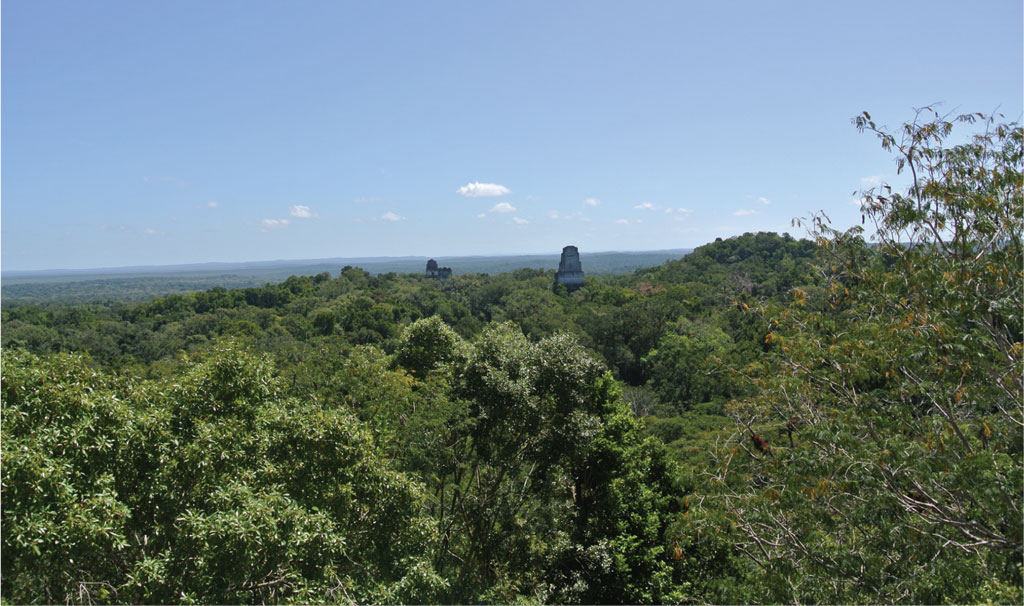
Sacred Spaces Make Contact With Nature
According to interpretations of different experts, the Maya religion was based in nature. The builders were assured they were building sacred temples of the bodies of the different natural forces. For example, Complex Q, the twin pyramid complex, personified the twin heroes, Hunahpu and Xbalanque, Sun and Moon. The nine doors building there (a form typical of twin pyramid complexes) to the south of the plaza represented the nine doors to the underworld where Xquic, mother of the hero twins, came from Xibalba. And the fourth pyramid to the north was just a place to worship the k’atun period of twenty years. The buildings were sacred places to have contact with those natural forces.
Archaeologists used to say the Maya were polytheistic. But if you talk with modern Maya priests, they are sure they believe in only one god—Hunab Ku. The others are personifications of natural forces such as rain, sun, and wind. Hunab Ku has no personification— Mayas sometimes represented Hunab Ku with a ring with no beginning or end, the cyclical universe. All the other things come from the universe and are part of the universe. But the people need to see something to believe. For example, the big mask with the low nose and lightening shape, this is rain or Chaac. Nature is our mother. All the parts of nature are our brothers. You have to respect everything—trees, animals, plants, because it is all part of this one unique thing, Hunab Ku, we call god.
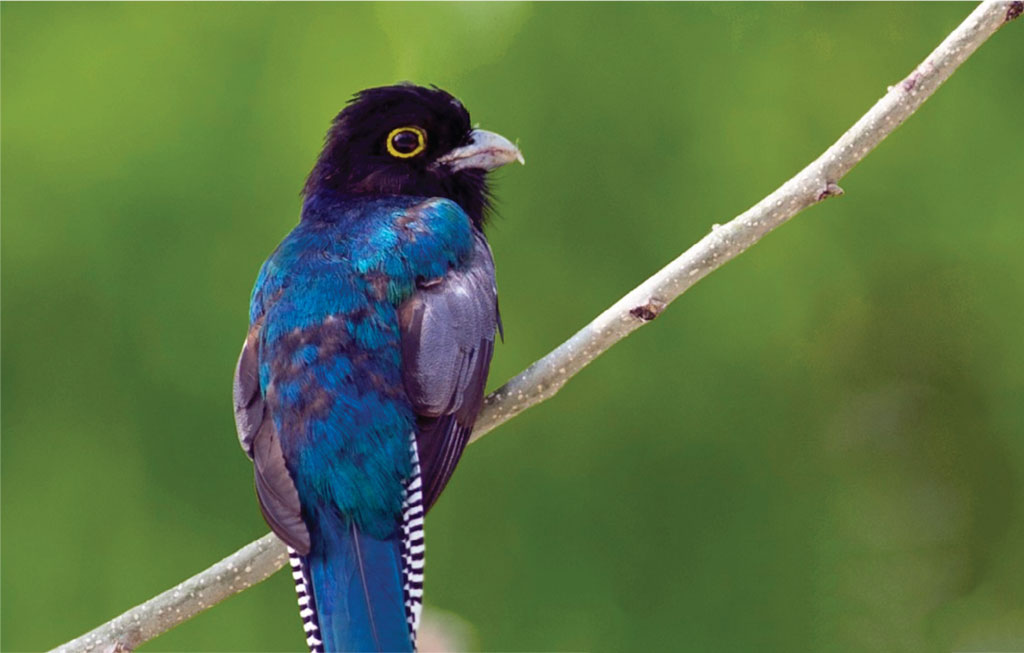
The Ceiba tree (Yax che, big tree or life tree) is very special because it is the tallest tree in Guatemala. For that reason, the Maya took it to be the connection between the underworld, the natural world, and overworld. Since 1952, it has been the national tree of Guatemala. In Tikal, we also have mahogany, cedars, and the ramón tree. Maya mixed ramón fruit with corn to make tea and tamales. We have medicinal and aromatic plants, and 64 different species of orchids. We have primary forest and still have the natural food chain conflict. I have seen jaguars several times, eagles, hawks, king vultures, toucans, trogons, white tail deer, tapir, pumas, and ocelots. We have hundreds of beautiful birds, 300 species in Tikal.
Every Maya Person Dreams of Going to Tikal to Visit the Souls of Their Ancestors
Since 2002, the Guatemalan Government recognizes Maya people as authentic descendants and established their political and cultural rights. They are allowed to visit archaeological sites, which are living ceremonial centers, without fear. They just need to notify the Park director and can hold their ceremonies. I always like to speak with Maya people at Tikal. In the Highlands, Maya shaman are really connected with the past. They honor Tikal, the largest ceremonial center where the souls of their ancestors are located. Every Maya person dreams of going to Tikal once in their lifetime to visit their ancestors. But it is very far for them to travel, so they use the closer archaeological site of Iximche, though it was mostly destroyed by the Spanish in the 16th century. The shamans were able to conserve the moon calendar because this is connected with agriculture. Through the living religion they know the moon calendar very well. The sun calendar was forgotten because the conquerors destroyed the Maya books and the intellectual people. However, the basic knowledge is still present in Guatemala today. Now archaeologists are giving the knowledge to the people, and they are integrating that knowledge into their daily lives.
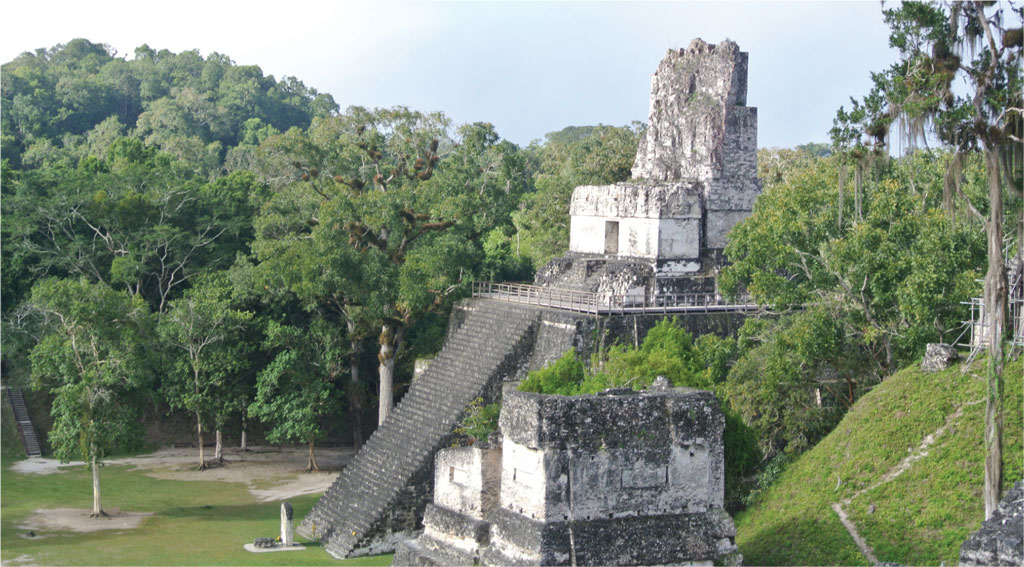
A Vibrant, Living Culture
Our government just gave our people legal recognition, but international entities like NGOs, universities, and European governments support the Maya cultural process that is pulling up the Maya people. In the last ten years they are starting to feel proud to be Mayas and are recovering their histories. Much of this history is coming from the archaeologists. My job is to make the people fall in love with the Maya culture. We have one unique thing in the world and that is a living, alive culture. You can see the great past, but you can also go inside among the Maya. You can’t do this in other places. Here you can still see and experience and be among the Maya who are practicing their beliefs, still wearing their garments, speaking their languages, and talking about nature in the same way the ancient Mayas did.
Fernando Madrid is a professional tour guide at Tikal National Park, in Guatemala. Lucy Fowler Williams, Ph.D., is Associate Curator and Sabloff Senior Keeper of Collections in the American Section of the Penn Museum. A cultural anthropologist, her research interests include issues surrounding Indigenous identity.
